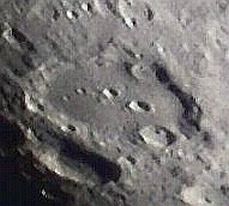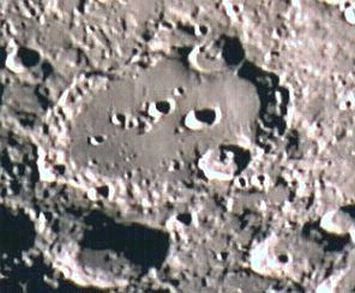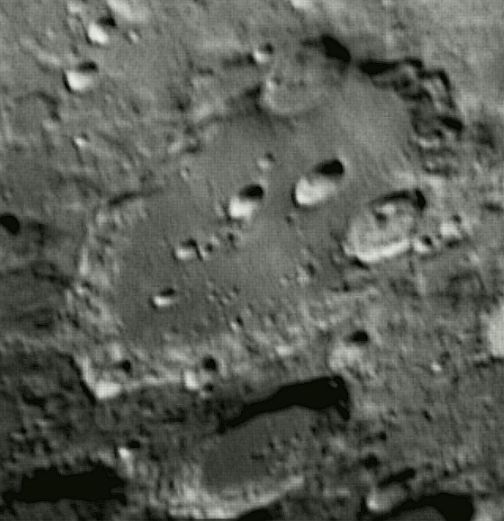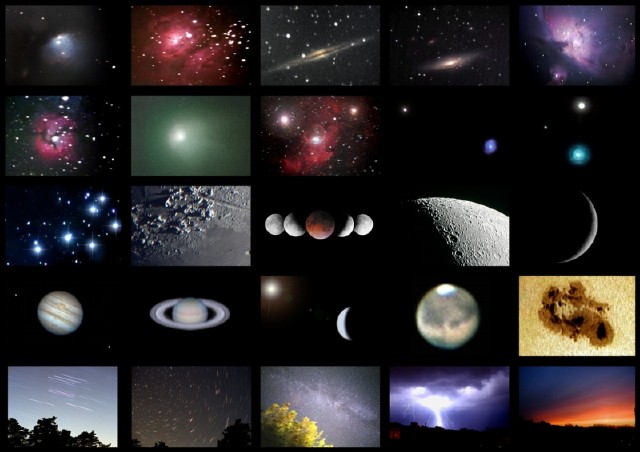Last updated: 30 June 2005
|
Last updated: 30 June 2005 |
This page documents astrophotography comments, tips, and photos. Contributions welcome. Be certain to see the other articles on the main Astrophotography page.
Subject: Digital Camera?
Sent: Thursday, June 30, 2005 15:41:51
From: Ben Vazquez (benzene0377@hotmail.com)
I've been reading through your web site for quite some time now and I
have a question for you. I'm looking to buy an inexpensive digital
camera to start taking pics with my etx105 and lx200 gps 12". I've seen
a couple different cameras but im really not sure what to buy. I was
looking at the Nikon CoolPix 995 since that is the one you have used
inthe past, and it has that bulb setting for 1min open shutter. I'm
wondering what you would recomend for under $300?
Thank you in advance for any help,
Ben Vazquez
Mike here: Certainly the Nikon CP995 and similar are good choices. You need a bulb setting and someway to fire the shutter without touching the camera. Having a macro or zoom lens helps for getting the camera lens as close as possible to the eyepiece focal plane. Having a fully manual mode is also good. I haven't researched the digital cameras since my purchase of the Nikon Coolpix 995 and of course now I have the Nikon D70 DSLR. Any digital camera that meets those basic specs will work. HOWEVER, don't expect great shots immediately; you will have to get some techniques down.
Subject: Polar alignment problems Sent: Sunday, June 26, 2005 11:18:34 From: Luis Villa (ETX_125EC_from_arizona@msn.com) Finally solved the parfocal problem. Attached is a picture of M-11 Wild Duck cluster. (actually two, to show my problem) But as you can see there is considerable star rotation. The scope was in Polar Alignment, (more on this later) I used a Meade 32 MM on the main eyepiece, and used my coolpix 4500 on a Scopetronix 18 MM eyepiece in the rear attached to the scope by way of a Large Accessory Ring adapter and Meade eyepiece holder that I purchased from Scopetronics. Attached to the 18 MM is a Lumicon Deep Sky Filter. (I had been taking pictures of the Ring and Dumbbell Nebula- they also show lots of star trails, and did not want to mess with taking the filter off) These are my camera settings: only difference between the two pictures is the time. DSCN0189.JPG CAMERA : E4500V1.2 METERING : MATRIX MODE : M SHUTTER : 45.35sec APERTURE : F3.0 EXP +/- : 0.0 FOCAL LENGTH : f7.9mm(X1.0) IMG ADJUST : AUTO SENSITIVITY : ISO800 WHITEBAL : AUTO SHARPNESS : AUTO QUALITY : 2272x1704 FINE SATURATION : 0 FOCUS AREA : CENTER Now to my big problem. Polar Alignment! I have read just about every article on the subject on your web site. I have printed out all of them for off line reading. I just cannot seem to "get" how to do it! Do you know of any videos on the subject? I have been more of an audio visual learner and would like to try learning this way. I have tried the Kochab clock article--- there is something I am missing! Any suggestions? This is the first picture using 45 second exposure.Mike here: I didn't see any field rotation but trailing is evident. This obviously comes from the telescope not accurately tracking the sky. This can be caused by several problems (assuming you are using an Autostar-controlled telescope): imprecise Autostar alignment, imprecise drive training, out of balance condition due to the camera weight (and since you have mounted the camera on the rear port this could be the culprit, singly or in combination with others), incorrect drive ratios in the Autostar, not having done a CALIBRATE MOTORS (especially if you have changed the power source or the batteries are getting weak). Using some sort of manual guiding method (an off-axis guider in this case or a higher power telescope piggybacked on the main telescope) can also help for long duration exposures (and 45 seconds IS long duration at the image scale you are using).Now here is the 60 second exposure taken immediately before the 45 

And:
Thx! The one thing that does stand out is the balance of the scope. I used new batteries, trained drives, recalibrated, set drive ratios to what is suggested in one of the articles, I.e. 15 and 1--in short, I re-did everything. Thanks for the suggestions, I will see if I can get this down pat... I will concentrate on the balance for now and see if this will resolve some of the trailing... My alignment last night appeared to be fine, (for photography, I thought this was the problem) I had the ring nebula dead center for about 10 minutes with no correction necessary, I don't know how long it would have been dead center in the 32 since I then slewed to others, M27, M11, etc... my problems started when I attached the camera... so it leads me to believe that balance is indeed the problem. Hey, with all these little problems, I am still having lots of fun trying!! AND I am learning along the way. Besides, it is not as if the Messiers are going anywhere! As always, you and your site have helped me tremendously! LuisAnd:
I hope to have some positive results soon. Work schedules have limited my tries to Fridays and Saturdays only, but this week will be different. Wednesday and Thursday nights I will be out and trying to image. Watch, it will probably be cloudy! Using a 40MM Meade Series 4000 Super Plssl- on the top port and a Meade 26MM in the rear port with the Large Accessory Ring along with a Meade eyepiece holder and a 1" eyepiece extension on the 26 with a parfocalizing ring makes both parfocal. I have attached my CoolPix 4500 to the 40MM using a Scopetronics Digi T adapter. I am hoping to send some images to the site by Friday morning! Weather permitting of course! Luis
Subject: camera exposure Sent: Sunday, June 19, 2005 11:11:21 From: Mark (ab2ml@optonline.net) I tried to take a picture of Jupiter but all I ever seem to get is a blob of light. too bright for the camera?....using a Fuji finepix 210.....would really like to get Jupiter but don't know what I'm doing wrong.....MarkMike here: Yes it is bright so the exposure could have been the problem unless blurring due to telescope movement was the culprit.
And:
Ok Thanks Mike.....I'll see what I can do about the exposure...camera is pretty limited in control but maybe I can find a way. MarkAnd more:
I just took a look at my camera again and found it has more exposure control than I thought. Hadn't gone far enough in the menu before....it has EV exposure nos....+- >3 .6,.9 EV etc.....it will go as low as 2.1...do you have any recommendation on where to start?. Or is it going to just have top be trial and error....I have a feeling that's going to be it....will be a little hard because the image of Jupiter is so small in the camera LCD screen....I'm using a 32mm plossl which seems to work best with the camera but I suppose other eyepieces with a sufficient eye relief would work.......MarkMike here: A common technique is "bracketing the exposures" which means "use them all". That way you have a better chance of getting a properly exposed one. Also, you can use a magnifier to help see the image on the viewscreen. That is one of the reasons I got a "Digital Camera Hood, "SLR" Attachment" as discussed on the Accessory Reviews: Astrophotography page.
And:
Thanks Mike for the info....I'll do the bracketing...and the magnifier is an outstanding idea...I guess sometimes the most simple solutions are the most elusive...going back to look more at the astrophotography page.....MarkAnd:
I did a bunch of bracketed pictures of Jupiter and finally got a good shot..Thanks for the advice on that......Mark
Subject: Mounting a camera on a equatorial mount tripod Sent: Friday, May 27, 2005 19:10:26 From: Farbzilla . (farbzilla@hotmail.com) I am just starting out in learning astrophotography and I purchesed a Orion EQ-2 Equatorial mount with the optional tracking motor. I also own a ETX-90EC and plan on piggy backing my 35mm film camera on it. I want to mount my Canon EOS-10D on the Equatorial tripod and am lookin for some ideas on how to do so. Any plans ideas links ect will be a great help.. Thank you....Mike here: While I don't know if they have what you need, check Scopetronix and ScopeStuff.
Subject: Moon - comparing ETX-70 / ETX-125 / LXD55 SN-10 Sent: Friday, May 27, 2005 07:56:05 From: Dieter.Wolf@DNSint.com (Dieter.Wolf@DNSint.com) comparison between the MEADE ETX-70AT / ETX-125EC and LXD55 SN-10 on the great walled plain of Clavius. All done at comparable phases of the moon with Philips ToUCam pro at prime focus. The ETX-70AT with 3x barlow, 10 out of 230 frames shows clearly Clavius T (9 km in diameter) and details down to about 7 km.The ETX-125EC with 2x barlow and 50 out of 500 frames reveals details down to about 4 km (like Clavius O). 
The LXD55 SN-10 with 3x barlow and 10 manually selected frames out of 1000 (!) - terrible seeing - has a resolving limit of 2 km (about 1 arcsec) 
I was pleased with the nice resolution of the ETX-70, with 350mm focal length not at all a moon / planetary scope. The ETX-125 at f/31 did what I expected (the scope feels pretty well at sun, moon and planets). With the SN-10 it was a hard work to - manually - select the few good frames to stack. In my experience the larger aperture the more difficult to get good frames of extended objects. Although it has a better resolution because of it's larger apperture I will normally not use it for moon/planets but for deep sky objects. Thanks for posting and have a nice day (night), Dieter from Munich, Germany 
Subject: Astrophotgraphy rookie Sent: Saturday, May 21, 2005 09:48:13 From: John and Mary (jrfmef636@msn.com) I have been wanting to start taking pictures, but after reading a couple of the astrophotography stacking program instructions, I can not tell how many pictures I should take, or should I just make a bunch of copies of one and use them...etc. Can you give me a site that starts with the absolute basics of astrophotography? They all seem to start off assuming you already know some of the basics. Thanks JohnMike here: Each image needs to be unique and NOT an exact duplicate of a single image. So, yes you take two, three, five, tens, or hundreds of images and stack them. There are many help links on the Helpful Information: Astrophotography page on my ETX Site.
Subject: ETX90 possible Sent: Saturday, April 30, 2005 14:05:38 From: geheniau@xs4all.nl (geheniau@xs4all.nl) Here some highlights what you can do with an ETX90, or a simple digital camera.Job Geheniau The Netherlands 
Return to the top of this page.
Go to the March-April 2005 Astrophotography - Tips page.
Go to the January-February 2005 Astrophotography - Tips page.
Go to the October-December 2004 Astrophotography - Tips page.
Go to the July-September 2004 Astrophotography - Tips page.
Go to the April-June 2004 Astrophotography - Tips page.
Go to the January-March 2004 Astrophotography - Tips page.
Go to the 2003 Astrophotography - Tips page.
Go back to the Astrophotography Page.
Go back to my ETX Home Page.